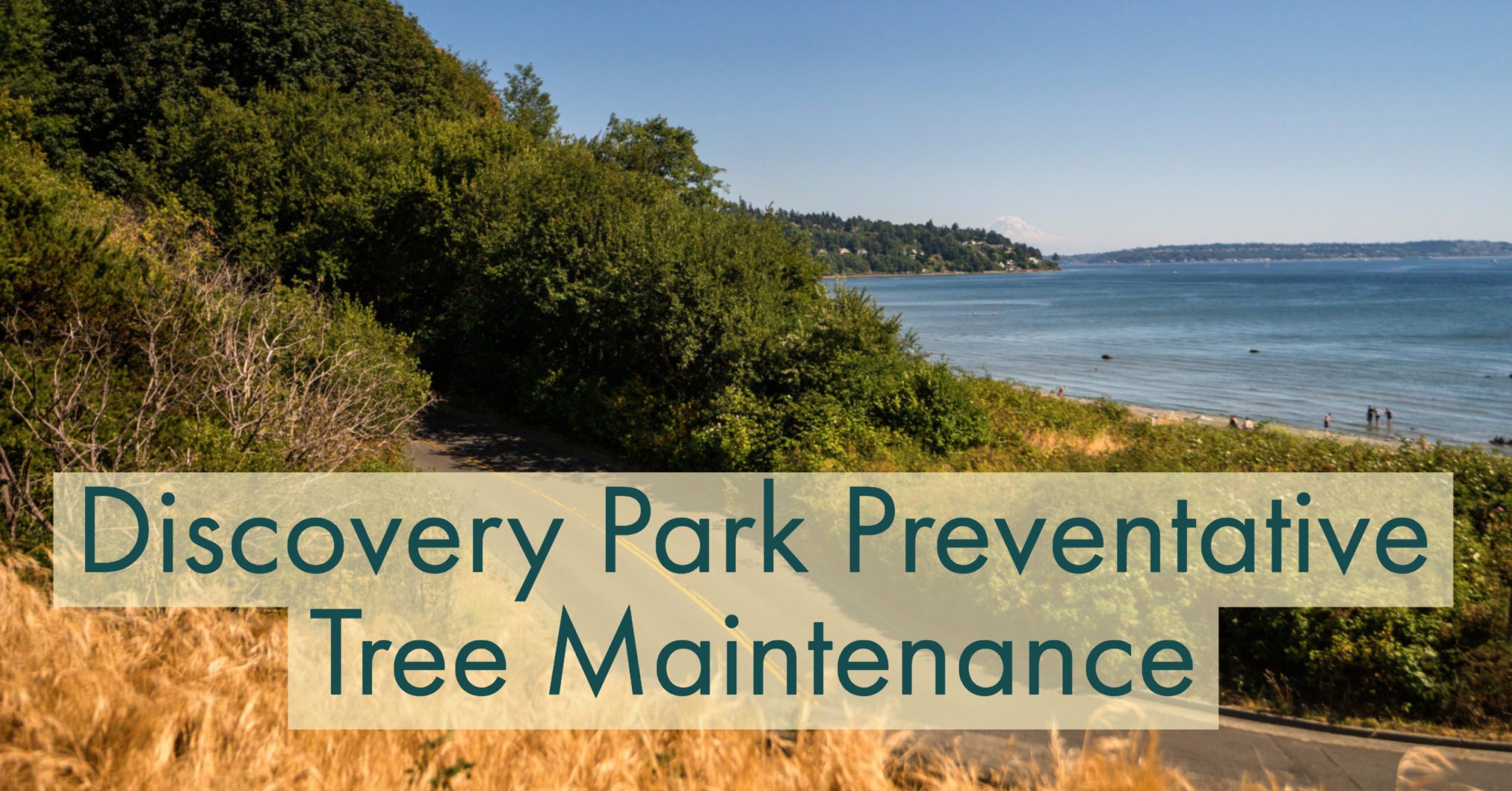
The Preventative Tree Maintenance crew will begin preventative tree work at Discovery Park in February 2018. This work is part of our Preventative Tree Maintenance Program, which aims to reduce risk related to trees and improve the long-term health of trees throughout our parks system. The work at Discovery Park will include trees at Discovery Park, Discovery Park Boulevard and Daybreak Star. This work will address trees that were surveyed by a contractor in the summer of 2016. Trees that have been inventoried and have some recommendation of work are indicated by blue tags. The recommended work ranges from a more thorough inspection to tree pruning or full tree removal.
All trees included in this inventory are within a 50′ buffer zone of high-use areas, including areas bordering streets, parking lots, education centers, paved trails, and play areas and playgrounds. Crews will not be working in natural areas of the park unless the natural area borders one of these high-use areas. Discovery Park will remain open during this work; trail detours and periodic closures of specific areas may occur. Work will begin along Emerson St. and continue counterclockwise to the entrance of the park. In total, we will address 166 trees. The long-term health of both our natural areas and wildlife are important to us. When staff consider the location to be appropriate, wildlife habitat snags, decayed wood, and sometimes whole dead trees will be retained in our natural area system.
Most of the trees that will be removed at Discovery Park are either dead or in decline due to a variety of reasons, such as soil compaction, damage due to construction, drought, or they simply reached the end of their life cycle. These trees are mostly big leaf maples, willows or alders. Some trees will also be removed because they pose a risk to the public that was deemed inacceptable by our Urban Forestry staff. Many of these trees have already experienced tree failures or are more prone to them in the future due to their natural growth pattern or their structural state.
All removed trees will be replaced at a 2:1 ratio. Staff will also be working with the Green Seattle Partnership to restore and replant additional native trees to sustain our urban parklands.
Questions? Join us for an Open House and two Arborist Tours
Open House: Join us at the Discovery Park Environmental Learning Center Classroom on Tuesday, Feb. 13 from 4 to 5 p.m. to learn more about this project and ask questions.
Arborist Tours: We will host two Arborist Tours, one on Friday, Feb. 23 and one on Monday, Feb. 26. The tours will start at the Discovery Park Environmental Learning Center parking lot at 12 noon. We expect the tour will take one hour. The tour will provide the opportunity for community members to walk through the park and learn more about our preventative maintenance efforts with one of our certified arborists.
Timeline: February 2018
Budget: Funding comes from the Seattle Park District’s Maintaining Parks and Facilities initiative, under the associated project “Provide Clean, Safe, Welcoming Parks”. Explore the Budget.
Preventative Tree Maintenance Overview
Seattle Parks and Recreation (SPR) stewards 6,412 acres of land with more than 300,000 trees. SPR’s Tree Preventative Maintenance Program works to systematically reduce tree associated risk in our park system by inspecting trees located within high-use buffer zones at 480 of our parks. The buffer zone includes any elevated use area (e.g., wading pools, beaches, playgrounds, playfields, paved surfaces) extending out 50 feet. There are an estimated 171,615 trees in the Seattle park buffer zones.
All trees in these areas identified as moderate risk or above will be addressed, and all young trees will be pruned. The program aims to inspect trees in high-use buffer zones at all SPR parks within a seven-year period, after which the process will begin again.
Program Objectives:
- Reduce risk associated with trees in SPR parks
- Improve the long-term health of trees in SPR parks
- Systematically address tree listed in SPR tree inventory
- Retain veteran trees in SPR parks. Larger trees provide more benefits to residents then smaller trees, so the removal of large trees should only occur when pruning methods have been deemed not feasible
- Maintain and create habitat for wildlife. Consideration will be made for birds, animals and insects. Habitat will include nesting and foraging spaces.
- Provide a citywide environmental education and awareness of public tree management.
Details
Click here to see a map of the trees that are scheduled to be pruned or removed. Click here to see a spreadsheet inventory detailing which trees will be pruned and removed.
